Friar William of Rubruck's 13thC Travels to the Mongolian Courts
This article is a discussion of European representation of cross cultural contact via the intermediary Friar William of Rubruck, a 13th century traveler to the Mongolian courts of the Great Khans. The focus is primarily to attempt to read the responses of local peoples that Rubruck encountered through his own travel writings, consider the importance of his account and his general role in history.
“O the most excellent lord and most Christian Louis, by the grace of God illustrious King of the French, from Friar William of Rubruck, the meanest in the order of Minor Friars, greetings, and may he always triumph in Christ. It is written in Ecclesiasticus of the wise man: “He shall go through the land of foreign peoples, and shall try the good and evil in all things."
(Rubruck, Chapter I)
These words written by Friar William of Rubruck (c.1210 - c.1270) in his report to King Louis IX of France preface a detailed account of the Flemish Franciscan monk’s travels to the Mongolian courts of Batu and Möngke Khan in 1253-1255. William of Rubruck undertook his mission to the Mongols with the dual purpose of promoting conversion to Christianity and gauging support of the Mongols for Crusades on behalf of King Louis IX.
His journey took him through the southern steppes to the Mongolian capital of Karakorum, giving him the distinction of being the first European to have completed and documented the trip. His journey lasted nearly three years and upon his return Rubruck presented Louis IX with one of the most detailed, precise and valuable early Western accounts of Mongol traditional culture entitled Itinerarium fratris Willielmi de Rubruquis de ordine fratrum Minorum, Galli, Anno gratia 1253 ad partes Orientales. (Jackson, Review Article, pg 92)
Rubruck was one of a number of mendicant friars who made the journey east. His most notable predecessors were the diplomatic envoys of Pope Innocentus IV, the Dominican Friars Andrew of Longiumeau and John di Plano Carpini whose missions were to recruit the Mongols in the Christian crusades against the Muslims.
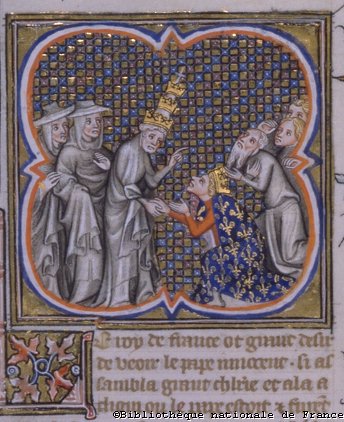
Louis IX meeting Pope Innocent IV at Cluny
14th century Manuscript - Grandes Chroniques de Frances, Paris
Rubruck’s Contact Zone
Rubruck’s travels created a unique 13thC contact zone between East and West, which is accessible to us via his report to King Louis of France. Mary Louis Pratt, in her book, Imperial Eyes, Travel Writing and Tranculturation, tells us that contact zones are social spaces where “disparate cultures meet, clash and grapple with each other, often in highly asymmetrical relations of domination and subordination” (Pratt, pg 4). Rubruck’s missionary travels created a significant temporal and geographical contact zone spanning three years and thousands of kilometres from Constantinople (Istanbul) to Qara Qorum (Karakorum) where Rubruck and his companions struggled with the cultural, religious, political and linguistic differences between themselves and the people they encountered in the Mongolian Empire.
Rubruck’s astonishing objectivity has left a unique record of his interactions and exchanges with Mongolian people across the social hierarchy, from nomadic herdsmen to his audiences with the powerful Khans who ruled the Mongolian Empire. These meticulously recorded encounters document the intimate ‘contact zones’ and provide insight into this clash of East meeting West in the 13thC. His extraordinary account allows us to scrutinize the cross-cultural interactions between these individuals who had traditionally lived on opposite sides of imperial and cultural frontiers (Pratt, pg 6).
Rubruck’s mission was to investigate claims that Nestorian Christians were established in the Mongolian cities, to preaching Christian precepts and hopefully converting more people to Christianity and to ascertain the likelihood of finding allies amongst the Mongols. His travels created a “spacial and temporal copresence of subjects previously separated by geographic and historical disjunctures whose trajectories now intersect” (Pratt pg7) the minute details of which Rubruck faithfully recorded in his report.
In examining Rubruck’s records of his journey within a cross-cultural framework, we attempt to discern the preconceptions Europeans had of the Mongolian people, investigate whether those stereotypes are reinforced or contradicted by Rubrucks account but also attempt to reveal evidence of the less present or even silent voices of the Mongolian ‘others’ with whom Rubruck interacted.
Historical context of Rubruck’s Document
“When I found myself among them, it seemed to me of a truth that I had been transported into another world."
(Rubruck, Chapter I)
Before being able to understand William of Rubruck’s travel writings as a historical source, it is vital to understand the context of the world in which Rubruck lived. Rubruck’s travel writing occurs five centuries before the emergence in the mid 18thC of a Eurocentric way of thinking that Pratt has come to term as “European planetary consciousness” (pg 15). While medieval scholars were cognizant of the sphericity of the Earth, to Rubruck and his contemporaries, the world was no larger than Europe, North Africa, the Middle East and the Far East.
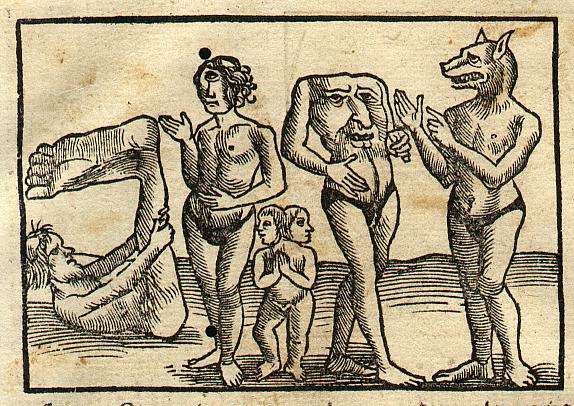
Medieval European monsters - Sciopods, Cynocephali (dog-heads) etc
15th C woodcut of Classical descriptions - The Nuremburg Chronicle c.1493
Medieval Europe knew little of their Mongolian neighbours and their preconceived notions derived from Classical authors such as Solinus and Isidore of Seville. These Classical writings of legend and myth gave rise to the belief that races of exotic monsters and freaks populated the far East. Races like the Cynocephali (people with dog’s heads) and a race of autopods were believed to inhabit the far East. In contrast to Carpini’s report which solemnly lists the existence of these freaks and monsters amongst the peoples to the North, Rubruck vainly enquired about them at the Khan’s court but came to the conclusion that the stories must not be true as he encountered no one who had seen or heard of them (Jackson, pg 51). “I enquired about the monsters or human freaks who are described by Isidore and Solinus, but was told that such things had never been sighted, which makes us very much doubt whether (the stories) are true.” (Rubruck, Chapter XXIX).
It was during these misinformed dark ages of the 13th Century that an alien tribe of nomadic people emerged from the steppes to militarily dominate the known world. With their fast sturdy horses, recurved bow and brutally effective military tactics, by 1241 the Mongolian empire stretched from the Carpathian mountains (Hungary) to the Pacific Ocean (China), opening a vast transit route between Europe and Eastern Asia which allowed trade, the flow of ideas and radical new intercultural exchanges (May, pg 133).
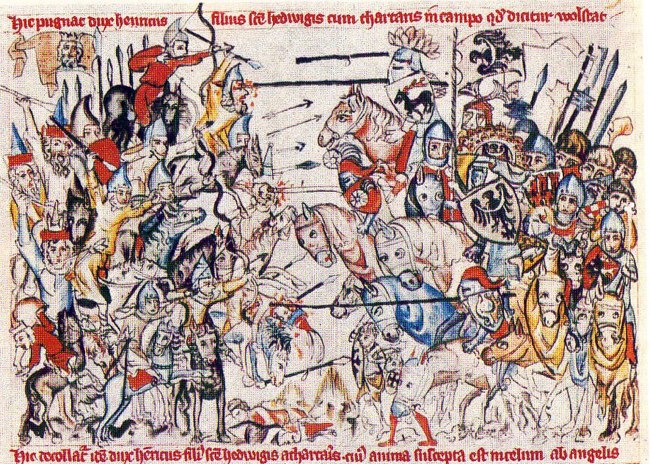
Battle of Legnica (legnitz) 1241. From Legend of Saint Hedwig
14th century Medieval illuminated manuscript, collection of Jagiellonian Library in Krakow.
On the left, the Mongolian barbarians are faced in battle with armies bearing the arms and devices of the Hungarian nobility.
The Mongolian Khans held a very simplistic view of international politics - the world had been given to the Mongol people by the Tenggeri (the Eternal Heaven) and all other rulers, whether cognizant of this fact or not, were subjects to the Khans. As such the Mongolian armies anticipated and extracted complete submission wherever they advanced. This submission was deemed to be merely the recognition of the duty owed to the Khans and not the intimidated and fearful submission of the newly conquered. Frequent missives containing ultimatums were sent to rulers whose lands lay in the Mongol advance informing the recipient that they were part of the world-empire of the Mongols, demanding submission, payment of tribute, and provision of soldiers to the Khan or face dire consequences for disobedience. It was Rubruck’s writing that first conveys the Mongols’ complete inability to comprehend why political envoys and representatives should bother to visit the imperial Mongolian court if it were not to bring submission (Jackson, pg 25).
Unaware of these Mongolian diplomatic precepts, Pope Innocentus IV embarked on a diplomatic campaign to approach the non-Muslim Mongolian people with the strategic aim of finding allies against the Islamic powers of the Middle East. These diplomatic envoys found neither what they desired, nor what they expected, in the perplexing Mongolian empire and due to the lack of religious uniformity, the prospect of allies amongst the Mongols quickly subsided (Tyerman, pg 993). It was amid this political climate that Rubruck made his mission to the Mongolian courts.
Travel writing
Traditional travel writing has been heavily grounded in the task of reinforcing the stereotypes of the Euroimperialism. Travel writing has enabled, created and maintained the dominance of the European metropolis and reinforced the perceptions of the colonial or frontier periphery for the benefit of the intellectual and literary reading public within that European expansionist framework. (Pratt, pg 6)
However, the political and religiously motivated diplomatic travel writings of the mendicant monks displays a different dynamic to their travel writing. As individual envoys or missionaries with few attendants, guides or interpreters these monks did not enjoy a dominant or even respected position during their travels. Treated as supplicants and untrustworthy foreigners their travel writings are not that of metropolitan European assessing and possessing the periphery, but rather it appears their positions in the asymmetrical power balance evident in these unique contact zones is reversed and the habitually dominant European becomes the peripherant engaging with the established metropolis of the powerful Mongolian Empire.
Prior to the European expansionist era of the 18thC, travel writing traditionally consisted of survival literature, civic description and navigational narrative for a Europe primarily engaged in maritime exploration. Following this period, European intellectual and commercial elites became more engaged in the new knowledge building endeavours of interior geography and natural history. While Pratt largely focuses on the scientific and sentimental modes of travel writing which were an intense source of public interest (Pratt, 23-25), the accounts of various missionary monks who travelled into Eurasia of the 13thC bear only some resemblance with these later travel writings through their cultural observations, geographical information and in Rubruck’s case, mentions of various animal species previously unknown to Europeans.
The travelling mendicant monk
The monks of the mendicant orders are those who have taken religious vows of poverty and celibacy in order to dedicate themselves to a life of disciplined religious practices. Originally hermits and later living in monasteries or travelling as missionaries, they subsist solely on the alms and charity. Their missionary endeavours made them obvious envoys for papal and secular rulers in the middle ages.
John de Plano Carpini, a Dominican monk and official legate of Pope Innocent IV travelled from Lyon enjoyed “something like a triumphal succession” as he progressed through Mongolia to the seat of the Great Güyük Khan in 1247. After arriving back in Lyon, he was sent onto Paris for an interview with King Louis. Carpini writes in the methodically detachment of the diplomat and records primarily his diplomatic interactions, their successes and in particular their failures. (Jackson Review article, pg 92)
Andre of Longjumeau headed an embassy to the Mongolian Khans in 1245-46 and again in January 1249 after Louis IX received Mongolian representatives at Cyprus who bore letters of uncommon civility from the Mongolian General Eljigidei. Charged with expensive gifts and letters, Longjumeau travelled to Mongolia unaware that Guyuk Khan was already dead when the letters had been written. He was instead received by the Khan’s widow, the Empress-Regent, Oghuk Qaimish who deliberately misrepresented Longjumeau’s presence as French submission and his gifts as rightful tributes to bolster her flagging support. Longjumeau was sent back to Louis IX with the more customary letters of ultimatum demanding further tributes. After such a reception, Louis IX and Innocentus IV were keen not to reinforce this impression with future envoys. (Jackson, pg 30).
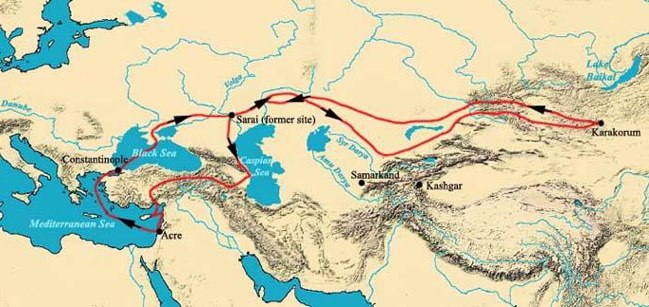
Map of Friar William of Rubruck’s journey of 1253-1255
Rubruck’s writing and reception
Rubruck’s travel writing is unlike the other diplomatic envoys of this period whose writing tends to the cool, methodical detachment of political expedience. Rather Rubruck’s approach is reminiscent of a personal memoir and he includes reactions to people, places and situations, whether they be joyful or fearful. Rubruck records information of many of the people he interacted with on his travels, not just great and powerful individuals such as the Great Möngke Khan, but also ordinary people he encountered in Karakorum (Jackson, Review Article, pg 92). Throughout Rubruck is careful not to give the impression he is an official envoy in an attempt to avoid Louis IX’s earlier humiliation resultant from Longjumeau’s embassage (Jackson, pg 39).
Many travel accounts by Europeans about non-European parts of the world have “produced ’the rest of the world’ for European readerships” (Pratt pg 5). Travel and exploration literature is often “celebratory, recapitulating the exploits of intrepid eccentrics or dedicated scientists” (Pratt pg 10-11) whereas Rubrucks’ writing, while still unavoidably Eurocentric, is quite different from others who wrote before him. His work is dispassionate, vivid and immediate (Jackson, pg 1) and his meticulous documentary style allows interpretation of Mongolian perceptions of Rubruck and his companions. While there are inherent limitations to gaining a comprehensive ethnographic representation of a people in the travel writings of an ‘outsider’, Rubruck’s straightforward style approach minimizes potential Eurocentric distortions allowing greater insight into Mongolian culture.
Discovery and Historical view of Rubruck
Centuries later, the modus operandi of Victorian era travel writers relied heavily on the whimsical and romantic rhetoric of ‘discovery’. Explorers would travel, ‘discover’ places, animals and objects usually known to local inhabitants already, and then report back or publish their ‘findings’ for the consumption of the various institutions of the European metropolis. An endeavour which proved a particularly prestigious and lucrative for many intrepid explorers (Pratt pg 204). Rubrucks’ writings on the other hand, are quite the opposite. Indeed Rubruck claims nowhere in his remarkable document to have ‘discovered’ anything. His account is neither celebratory of fantastic discoveries nor recapitulating of his hardships or exploits but his open minded report reads like the memoirs of a dedicated observer of human ethnography and natural history. Rubruck is generally credited with being the first European to have observed the landlocked nature of the Caspian Sea as well as the first to have documented the unfamiliar creatures such as the yak, the onager (Equus hemionus or wild ass) and the arghali (Ovis Poli or wild sheep) but these are clinical and factual observations in his account and it is later generations that have bestowed him these distinctions (Jackson, pp 36-37).
Marco Polo
Rubruck’s travel writings were penned some fifty years before the famous Marco Polo returned from his travels in the far East in 1295. The scientific superiority of Rubruck’s account has been commended by many authorities including Sir Henry Yule who mentions Rubruck favourably in the introduction to his 1903 translation of Marco Polo’s work The Book of Ser Marco Polo the Venetian Concerning the Kingdoms and Marvels of the East. Yule claims “Friar William’s letter as a Book of Travels of much higher claims than any one series of Polo’s chapters” (Jackson, pg 51). It is possible that Rubruck’s ambiguous status as neither diplomatic envoy nor ambassador caused his work to become obscure or perhaps the romantic readability evident in Polo’s travel writings, reminiscent of the Victorians who were to follow centuries later, appealed to 14thC popular culture which enabled Marco Polo’s travel writing to overshadow Rubrucks.
Rubruck’s Observations
Mongolian dwellings
“Nowhere have they fixed dwelling places, nor do they know where their next will be. Nowhere have they any ’lasting city’"
(Rubruck, Chapter II)
Rubruck discusses the nomad’s life with fascination and he records the social hierarchy minutely from the placement of their yurts (portable tent like dwellings made of wooden lattice and felted wool) to the traditional seating arrangements within. Yurts are always placed facing south, the direction of warmth and fire. When placing yurts the grounds are blessed in a shamanistic ritual honouring the south (fire); the east (air); the west (water); and the north (the honourable dead).
Rubruck’s commentary on Mongolian nomadic traditions is factual and consistent with European ideas of the ‘barbarian’ nomad lifestyle, but it becomes evident that he unexpectedly admires the logistical achievements involved in the nomad’s seasonal migrations.
“… they make these houses so large that they are sometimes thirty feet in width. I myself once measure the width between the wheel-tracks of a cart twenty feet, and when the house was on the cart it projected beyond the wheels on either side five feet at least. I have myself counted to one cart twenty-two oxen drawing one house, eleven abreast across the width of the cart, and the other eleven before them. The axle of the cart was as large as the mast of a ship."
(Rubruck, Chapter II)
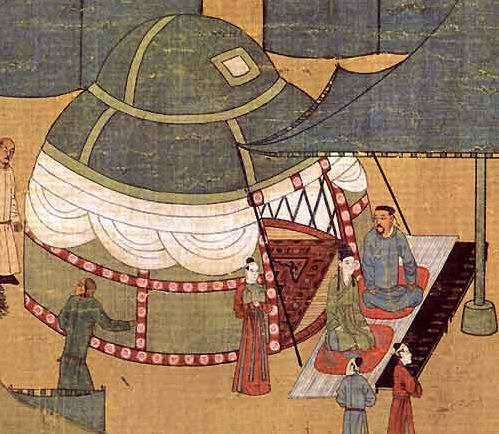
A Khitan royal yurt depicted in “The Stork of Lady Wen-Chi”
From a handscroll painting from a 12C depiction
[image placeholder]
Temujin sits in his yurt just proclaimed Genghis Khan 1305 Persian manuscript by Rashid al-Din
Milk, the lifeblood of the steppes.
“So long as lasts their comos, that is to say mare’s milk, they care not for any other food."
(Rubruck, Chapter III)
Mare’s milk is a valued commodity amongst the Mongolians for it is the primary ingredient in kumiss (called comos by Rubruck), a highly alcoholic drink used in their shamanistic rituals, feasts and courtly drinking ceremonies. Rubruck observes that mare’s milk is also used to pay tributes at the court of Batu Khan, “Batu has thirty men around his camp at a day’s distance, each of whom sends him every day such milk of a hundred mares, that is to say every day the milk of three thousand mares… so it is these (Mongols) must bring to the ordu (camp) of their lords the milk of every third day.” (Rubruck, Chapter IV) The concept of milk tithes is foreign to Rubruck but he conveys this information in a manner that gives the reader an impression that it seems logical for a nomadic people to provide valuable mare’s milk as currency to the court.
However, Rubruck is censorious in his observations on the drinking habits of the Mongolian people which may be a reflection of his Franciscan distaste for drunkenness. “Then they drink all around, and something they do drink right shamefully and gluttonly. Then they all drink in turn, men and women alike and at times compete with one another in quaffing in a thoroughly distasteful and greedy fashion.” (Rubruck, Chapter II)
The Mongolian’s attitude towards alcohol consumption is patently different to that of the western monk, they engage in ritualized drinking challenges and tease each other to drink heavily while they sing, clap their hands, stomp their feet and dance until everyone is drunk (Rubruck Chapter II). Indeed, Carpini also notes in his reports that the Mongols regard drunkenness as an ‘honourable condition’, and mentions that they continue drinking even after it has caused them to vomit (Carpini, Chapter IV). The drinking behaviour noted by Rubruck as distastefully gluttonous appears to be part of the Mongol’s normal social habits.
From Rubruck’s observations we learn that the Mongolian people have a great affinity with their livestock for their survival relies on their herds. He notes that cow’s milk provides milk, butter and gruit for the hard winters - “they boil it (the cow’s milk), and it curdles in boiling, and the curd they dry in the sun, and it becomes as hard as iron slag, and they put it away in bags for the winter. In winter time, when milk fails them, they put this sour curd, which they call gruit, in a skin and pour water on it, and churn it vigorously till it dissolves in the water, which is made sour by it, and this water they drink instead of milk.” (Rubruck, Chapter V)
Milk wasn’t a basic food item in medieval Europe and was primarily used in the making of butter and cheese. The process Rubruck describes of dehydrating milk for winter reconstitution depicts the Mongolian people to be quite advanced in food storage compared to their European counterparts in addition to being well adapted to their harsh climate.
Animals in the Mongol diet
“Of their food and victuals you must know that they eat all their dead animals without distinction, and with such flocks and herds it cannot be but that many animals die. So then if it happens that an ox or a horse dies, they dry it’s flesh by cutting it into narrow strips and hanging it in the sun and wind, where at once and without salt it becomes dry without any evidence of smell. With the intestines of horses they make sausages better than pork ones, and they eat them fresh. the rest of the flesh they keep for winter. With the hides of oxen the make big jars (bags), which they dry in admirably fashion in the smoke. With the hind part of the hide of horses they make most beautiful shoes."
(Rubruck Chapter III)
Rubruck notes that all manner of animals are eaten including mice, rats, marmots and other small prey which are procured by hawking. Larger wild prey is hunted in groups using military flanking tactics and recurved bows. Rubruck’s observations tell us that the Mongolian people ate all animals and considered no animals sacred. Also evident is the extreme thriftiness of the Mongols who need to survive extremely harsh conditions.
Domestic arrangements of men and women
Many traditional historical sources, travel narratives and mass imperial or religious documentation often sees the role of women as less prominent or obscured in depictions of various ethnographic cultures (Ballentyne & Burton, pg 411). Rubruck’s domestic observations however, appear equally inclusive of the duties, conditions and situations of women as well as those of men.
Yurts are arranged in accordance with a structured hierarchy where the “first wife places her dwelling on the extreme west side, and after her the others according to their rank, so that the last wife will be in the extreme east”. Accordingly the wife will always sit to the east of her husband as the “west side of the house is for the men… men coming into a house would never hang up their bows on the side of the woman.” (Rubruck, Chapter II) When a man has several wives, whomever he has slept that night sits beside him in the day and any gifts received that day go to the treasury of that wife.
“Beside the entry on the women’s side is a cow’s tit for the women, who milk the cows: for it is part of the duty of the women to milk the cows. On the other side of the entry, towards the men, is another statue with a mare’s tit for the men who milk the mares."
(Rubruck, Chapter III) 55
We learn from Rubruck’s observations that Mongolian society is predominantly patriarchal. Women are ‘owned’ by their fathers until they are sold to their husbands. Should a woman have the misfortune to be widowed it is unlikely she will remarry as it is believed she will return to her original husband in the afterlife. The only man who might marry her is one of her husband’s sons who, it is considered, will not be aggrieved when she returns to serving his father in the afterlife. This practice Rubruck notes as ‘shameful’ but appears to report factually and dispassionately on most of the domestic practices of the Mongolian people (Jackson, pg 92).
The subservient position of women sees many of their customs, rituals and domestic duties divided on gender lines. Men hunt, make bows and arrows, fashion saddles, tend the horses and collect mare’s milk for fermenting into alcohol, while women drive wagons, load and unload yurts, sew skins into clothing, make shoes and other garments, collect cow’s milk, make butter and gruit as well as collecting and drying dung for heating. (Rubruck, Chapter VII)
Religion
As a religious mission, Rubruck’s progress was a complete failure. The Mongolians to whom he preached Christianity were unprepared to “receive baptism, since this meant he (one) could not drink the comos: the Christians in this country claimed that nobody who was truly a Christian should drink it, and he (one) could not survive in that wilderness without the drink. I (Rubruck) was wholly unable to disabuse them of this idea.” (Rubruck, Chapter XII). The concept of Christians abstaining from kumiss gained momentum from Russian communities who lived amongst the Mongols. Given the heavy reliance of the Mongol people on kumiss for sustaining their very way of life the perceived sacrifice was too great (Jackson, pg 104).
Being of religious orders, naturally Rubruck’s report has many religious observations. He remarks on the lax practices of the Nestorian Christians that he finds in Karakorum as well as recording his surprise at finding an Islamic presence in inner Asia. The most remarkable religious observation Rubruck however is a record of a debate he engaged in at Möngke Khan’s request where the Christians, Muslims and Tuin (shaman priest) were encouraged to determine which faith was correct. Rubruck writes that the debate went the way of the Christians, the Muslim having conceded that there is only one God, and the Tuin representative being rendered speechless against Rubruck’s arguments and yet Rubruck laments “They all listened without challenging a single word. But for all that no one said, ‘I believe, and wish to become a Christian.” (Rubruck, Chapter XXXIII).
At his last audience with Möngke Khan, Rubruck records that the Khan said to him “We Mongals believe that there is only one God, through whom we have life and through whom we die, and towards him we direct our hearts… But as God has given the hand several fingers, so he has given mankind several paths.” (Rubruck, Chapter XXXIV)
Rubruck’s general demeanour towards the Khans is largely that of fearful supplicant. He is aware he is in danger should he overstep unknown protocols and was unable to speak freely yet his final audience with Möngke Khan demonstrates that the Mongols were not just a horde of invading barbarians as was common belief in western Europe.
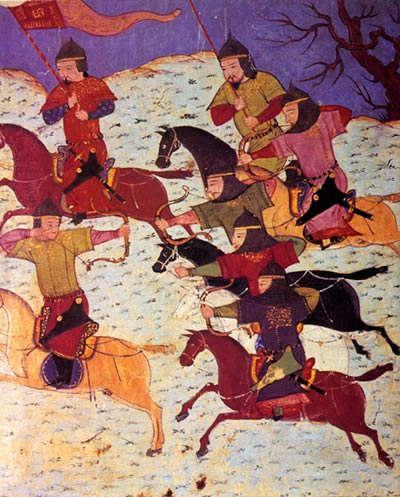
Mongolian Cavalry
Persian manuscript by Rashid al-Din
Bibliotheque national de France, Supplement Persan 1113.fol.231v
Mongol perceptions of foreigners
Rubruck’s predecessor, John of Plano Carpini, writes of the loyalty and honour the Mongol holds to himself and his people, but notes quite vehemently that this courtesy does not extend to foreigners and finds that the Mongol treats all strangers with contempt and insolence. (See Appendix; Carpini, Chapter V).
Rubruck’s travel writing also makes early mention that his guides are contemptuous of their occupation as tour guide to the foreigners and had an exaggerated perception of Rubruck’s lowliness due to the Franciscan’s vow of poverty - “at first our guide showed profound contempt for us, and was disgusted at having to guide such poor folk; but after awhile, when he began to know us better they would take us to the yurts of rich Mongals where we had to pray for them. If I had had a good interpreter I (would have) had opportunities for bringing about much good. Our guide took us to many of these and they would wonder greatly at our not receiving gold, silver or costly clothing…. they asked about our countries, if there were many sheep, cattle and horses there.” (Rubruck, Chapter XII)
Rubruck initially mistakes these enquiries for friendliness but realizes otherwise several months later when secretaries of Möngke Khan questions him about France and “whether there were many sheep and cattle and horses there, and whether they had not better go there at once and take it all.” At this time Rubruck notes “I had to use all my strength to conceal my indignation and anger, but I answered " There are many good things there, which you would see if it befell you to go there.” (Rubruck, Chapter XV)
Rubruck interprets the Mongols attitudes towards France as supremely arrogant (Rubruck, Chapter XXVII), but if one attempts to read with a cross cultural perspective, the Khan and his secretaries could not be expected to act in any other manner. Certain of the divine right of the Khans to ownership and eventual possession of France, the Mongols were taking inventory and acting and speaking in accordance with this belief.
Conclusions
Obscurity due to ambiguous position
While his mission was ostensibly to spread Christianity and to garner support for the Christian crusades against the Muslims, Rubruck “always insisted he was a simple missionary, but he was treated as an ambassador and behaved like a spy.” (Fernandez-Armesto pg 322). Rubruck’s long letter to Louis IX lay forgotten for three and a half centuries possibly due to his lack of official status, whereas Carpini’s account was copied and circulated for their diplomatic importance.
Limitations of Language
Rubruck’s report is couched in impartial dialogue which renders the perceptions of the Mongolian people difficult to ascertain. This may be in part due to language barriers. Every minute interaction that Rubruck attempts to record is enacted via a handful of interpreters, some of whose expertise Rubruck draws into question and on several occasions he expresses exasperation at their drunkenness; “but for our misfortune our interpreter was standing by the butlers, who gave him so much to drink, that he was drunk in a short time… He (Möngke Khan) had his interpreter, a certain Nestorian, who I did not know was a Christian, and we had our interpreter, such as he was, and already drunk.” (Rubruck Chapter XXVIII).
Rubruck’s remarkable document was written for a French king, by a Flemish monk of an Italian order, working for the Roman Catholic Pope, in a semi-educated Latin (Jackson, pg 51). It records a multitude of culturally diverse exchanges across a contact zone that spans several years and several thousand kilometres that were conducted in Mongolic, Turkic and Tungusic languages via the intermediaries of several variously unreliable interpreters (Jackson pg 17). Furthermore it has been several times translated from Latin into English for our consumption. It is uncertain whether Rubruck’s report is so moderate and objective due to his character, his lack of official political agenda or whether this is a by product of the limitations of language and his interpreters skills. Under these multilingual circumstances it is impressive that Rubruck was able to provide such an authoritative report of this fascinating contact zone.
Appendix:
The long and wonderful voyage of Frier John de Plano Carpini by John de Plano Carpini
Chapter V - Of their manners both good and bad.
[Their obedience.] Their manners are partly prayse-worthie, and partly detestable: For they are more obedient vnto their lords and masters, then any other either clergie or laie-people in the whole world. For they doe highly reuerence them, and will deceiue them, neither in wordes nor deedes. They seldom or neuer fall out among themselues, and, as for fightings or brawlings, wounds or manslaughters, they neuer happen among them.
[Their abstinence] There are neither theeues nor robbers of great riches to be found, and therefore the tabernacles and cartes of them that haue any treasures are not strengthened with lockes or barres. If any beast goe astray, the finder thereof either lets it goe, or driueth it to them that are put in office for the same purpose, at whose handes the owner of the said beast demaundeth it, and without any difficultie receiueth it againe.
[Their courtesie.] One of them honoureth another exceedingly, and bestoweth banquets very familiarly and liberally, notwithstanding that good victuals are daintie and scarce among them. They are also very hardie, and when they haue fasted a day or two without any maner of sustenance, they sing and are merry as if they had eaten their bellies full. In riding, they endure much cold and extreme heat. There be, in a maner, no contentions among them, and although they vse commonly to be drunken, yet doe they not quarrell in their drunkennes. Noe one of them despiseth another but helpeth and furthereth him, as much as conueniently he can.
[Their chastity.] Their women are chaste, neither is there so much as a word vttered concerning their dishonestie. Some of them will notwithstanding speake filthy and immodest words.
[Their insolencie against strangers.] But towards other people, the said Tartars be most insolent, and they scorne and set nought by all other noble and ignoble persons whatsoeuer. For we saw in the Emperours court the great duke of Russia, the kings sonne of Georgia, and many great Soldanes receiuing no due honour and estimation among them. So that euen the very Tartars assigned to giue attendance vnto them, were they neuer so base, would alwaies goe before them, and take the vpper hand of them, yea, and sometimes would constraine them to sit behinde their backes. Moreouer they are angrie and of a disdainfull nature vnto other people, and beyond all measure deceitfull, and treacherous towards them. They speake fayre in the beginning, but in conclusion, they sting like scorpions. For craftie they are, and full of falshood, circumuenting all men whom they are able, by their sleights. Whatsoeuer mischiefe they entend to practise against a man they keepe it wonderfully secrete so that he may by no meanes prouide for himselfe, nor find a remedie against their conspiracies. They are vnmanerly also and vncleanly in taking their meat and their drinke, and in other actions. Drunkennes is honourable among them, and when any of them hath taken more drinke then his stomacke can well beare, hee casteth it vp and falles to drinking againe. They are most intollerable exacters, most couetous possessours, and most nigardly giuers. The slaughter of other people is accompted a matter of nothing with them.
Bibliography
- Ballantyne & Burton; Bodies in Contact : Rethinking Colonial Encounters in World History, Duke University Press Durham and London 2005.
- Carpini, J.;The long and wonderful Voyage of Frier John de Plano Carpini, eBooks@Adelaide, University of Adelaide Library, South Australia 2010, Accessed 31/05/2010-04/06/2010
- Jackson, Peter;The Mission of Friar William of Rubruck : His Journey to the Vourt of the Great Khan Mongke, 1253-1255, Hackett Publishing, Indianapolis 2009.
- Jackson, Peter; Review Article: Itinerarium of William of Rubruck by Claude and Rene Kapper, Journal of the Royal Asiatic Society of Great Britain & Ireland, No. 1, 1987. pp 92-97 Royal Asiatic Society of Great Britain and Ireland
- May, Timothy; Review Article: Europeans and Mongols in the Middle of the Thirteenth century by Antti Ruotsala, Journal of the Royal Asiatic Society, Third Series, Vol. 13, No.1 April 2003, pp 132-134, Cambridge University Press
- Pratt, Mary Louise; Imperial Eyes: Travel Writing and Transculturation, Routledge London 1992
- Rubruck, William; Rubruck’s Report to King Louis IX of France, University of Washington, http://depts.washington.edu/uwch/silkroad/texts/rubruck.html, Accessed 20/05/2010-04/06/2010
- Tyerman, C.J.; Review Article: The Mission of Friar William of Rubruck: His Journey to the court of the Great Khan Mongke, 1253-1255, by Peter Jackson The English Historical Review, Vol. 109, No. 433, Sept 1994 pp.993-994, Oxford University Press
